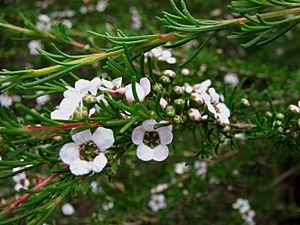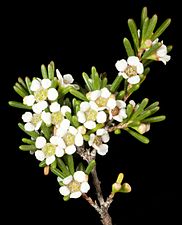Astartea facts for kids
Quick facts for kids Astartea |
|
|---|---|
 |
|
| Astartea fascicularis | |
| Scientific classification |
|
| Kingdom: | Plantae |
| Clade: | Tracheophytes |
| Clade: | Angiosperms |
| Clade: | Eudicots |
| Clade: | Rosids |
| Order: | Myrtales |
| Family: | Myrtaceae |
| Subfamily: | Myrtoideae |
| Tribe: | Chamelaucieae |
| Genus: | Astartea DC. |
| Species | |
|
about 22 |
|
Astartea is a group of flowering plants in the myrtle family, called Myrtaceae. These plants are special because they only grow in one place: the southwestern part of Western Australia. The name Astartea comes from Astarte, which was the Greek name for the goddess Ishtar.
Contents
About Astartea Plants
These plants come in many shapes and sizes. Some are tiny shrubs, only about 10 centimeters tall. Others can grow into small trees, taller than 5 meters.
Some Astartea plants have special woody growths called lignotubers. These help them grow back after a fire. Other plants can grow new shoots from their base. Astartea plants are usually smooth and don't have hairs. They often have tiny oil glands that stick out. New stems are square-shaped and sometimes have small wings.
The leaves often grow in tight bunches, called fascicles, along the younger branches. The leaves are thick and narrow. They are usually widest near their tips and have smooth edges.
Most Astartea species have single flowers that grow where a leaf meets the stem. The flower buds are wrapped in two small leaves called bracteoles. These usually fall off when the flower opens. Most flowers have five parts, like five petals. Sometimes, they can have six or even four parts. If a plant is stressed, it might make four-part flowers that open later.
As a bud opens, layers of petals unfold. The inner petals might look a bit crinkled. The smallest petals are found on A. arbuscula, only about half a millimeter long. The largest petals are on A. granitica, which can be about 6 millimeters long.
Most Astartea species have flowers that are white to light pink, or light to medium pink. Some A. arbuscula plants can have deep pink flowers. Some flowers have only a few stamens (the parts that make pollen), while others can have up to 60. This can change between different species, or even on the same plant. A few species also have staminodes, which are stamens that don't make pollen. The style (the part that receives pollen) gets longer as the flower grows. Its tip is dark red, and its base is lighter.
The fruit of Astartea is a hard, woody capsule. Some fruits open up to release their seeds, while others do not. Each fruit can have one or many seeds. Most seeds are about one millimeter long. Species that grow in dry places often have seeds with thick coats. Sometimes, there is also chaff, which are dry, papery bits.
Astartea plants can look different even within the same species. This can be due to their genes, how much rain they get, or if there have been fires. They also change with the seasons.
Where They Live and How They Interact
These plants usually grow in wet places. You can find them near puddles on rocks or along the edges of rivers and streams. Some also grow in swamps or on floodplains (areas that get covered by water).
Most Astartea plants are pollinated by insects. This means insects help move pollen from one flower to another. Native bees and jewel beetles are often seen on their flowers. Astartea flowers in the summer. This is important because many other plants have finished flowering by then. So, Astartea provides a good source of food (nectar) for insects in the summer.
Many insects that feed on plant sap can be found on Astartea plants. These include mirid bugs and tiny larvae of felt scales. Astartea plants often have strange growths called galls. These are likely caused by certain types of wasps. Some Astartea species have seeds that might be spread by ants.
Growing Astartea
Astartea plants are not hard to grow. In fact, they can sometimes spread easily if they escape from gardens. One type grown for gardens is called Astartea 'Winter Pink'.
Types of Astartea
In 2013, scientists looked closely at the Astartea group. They officially recognized 22 different species.
- Species
- Astartea affinis (Endl.) Rye – west-coast astartea
- Astartea arbuscula (R.Br. ex Benth.) Rye – minute astartea
- Astartea aspera Schauer – rough-stemmed astartea
- Astartea astarteoides (Benth.) Rye
- Astartea cicatricosa Rye & Trudgen
- Astartea corniculata Schauer
- Astartea decemcostata Rye – Barrens astartea
- Astartea eobalta Rye
- Astartea fascicularis (Labill.) DC. – Recherche astartea
- Astartea glomerulosa Schauer – early astartea
- Astartea granitica Rye & Trudgen – granite astartea
- Astartea laricifolia Schauer – winged astartea
- Astartea leptophylla Schauer – river-bank astartea
- Astartea middletonii Rye
- Astartea montana Rye – Stirling Range astartea
- Astartea muricata Turcz. – inland astartea
- Astartea onycis Rye & Trudgen – clawed astartea
- Astartea pulchella (DC.) Rye
- Astartea reticulata Rye
- Astartea schaueri Rye & Trudgen
- Astartea scoparia Schauer – common astartea
- Astartea transversa Rye
- Astartea zephyra Rye & Trudgen
Plants Once Thought to Be Astartea
Some plants were once believed to be part of the Astartea group but are now in different groups:
- Cyathostemon ambiguus (was A. ambigua)
- Cyathostemon heterantherus (was A. heteranthera)
- Seorsus clavifolius (was A. clavifolia)
- Seorsus intratropicus (was A. intratropica)
Gallery
See also
 In Spanish: Astartea para niños
In Spanish: Astartea para niños




